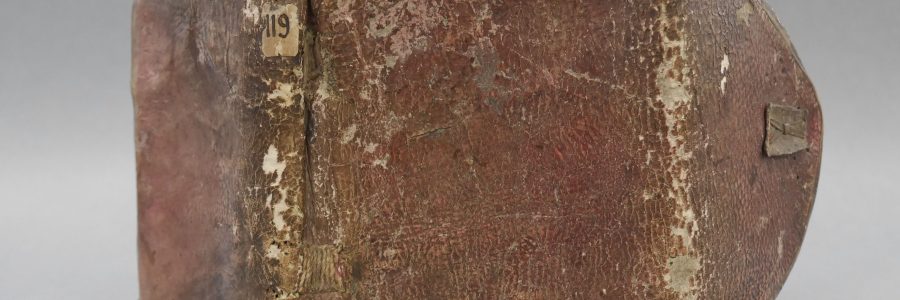
A previously unrecorded sewing technique from the 12th Century.
Posted on 11/04/2019 by Jim Bloxam
A new essay, by Jim Bloxam and Shaun Thompson, has been published in Suave Mechanicals: Essays in the History of Bookbinding, Volume 5, entitled: ‘A Previously Unrecorded Sewing Technique Deciphered during a Study of a 12th Century, Limp Tawed-Skin Binding’ 874.b.298(1-5). An examination of the materials and techniques used in the binding of Pembroke MS 119, Alain de Lille, Anticlaudianus are considered in the context of previous publications on limp structures. The authors’ study and conclusion seek to respectfully offer an addition to the existing body of work.
The following is a summary of the essay:
Pembroke MS 119 has an exceptional contemporary binding with interesting structural features, including a limp covering of alum-tawed skin that is stained red. The covering is further edged with a separate piece of unstained alum-tawed skin and was formerly fastened with an alum-tawed wrapping band. The sewn attachment of the text block to the cover is particularly interesting as the authors believe it to be a previously unrecorded technique.
Alain of Lille’s Anticlaudianus, is a long cosmological poem in Latin on theological and philosophical themes. It deals with knowledge and perfection and offers lessons on poetics, grammar, rhetoric, and philosophy. It was a very popular work in the monastic and cathedral schools, and survives in over one hundred manuscripts. Pembroke MS 119, written on parchment, is one of the oldest surviving witnesses of the text, copied not long after the poem was composed. The poem was written ca. 1182–1183, and this manuscript has been dated to the twelfth century. It is not known where the manuscript was written. However, M.R. James attributed it to Bury St Edmunds Abbey.
The binding of Pembroke Ms 119 indicates that it was intended, from its conception, for the private use of a professed monk, possibly in the Abbey of Bury St. Edmunds. Measuring 157mm x 125mm x 24mm, it is light, flexible, functional and portable. The binding is the work of an accomplished craftsman. Great care has been taken in the choice of materials appropriate to their function and durability; these materials have been exploited with great skill, indicating that the work is that of an experienced and highly proficient practitioner.
In her studies on limp bindings, Agnes Scholla notes three main types of attachment of text block to cover: adhered, tacketed , and sewn. She further subdivides sewing into supported sewing and unsupported sewing . Further subdivisions in the unsupported sewing section include link stitch and long stitch . Scholla records the sewing attachment, of cover to text block, for Pembroke MS 119 as long stitch, which would place it in the category of unsupported sewing[1]. However, after careful examination of Pembroke MS 119, Shaun Thompson deciphered a previously unrecorded type of sewing; a ladder/long stitch, sewn onto integral supports. The sewing, which forms the attachment of the cover to the text block, is executed at two independent stations . The supported sewing for Pembroke MS 119 is composed of one single piece of thread at each sewing station, which first forms the integral supports and then connects the text block and cover.

Left to Right. Diagram integral sewing support direction, integral sewing, diagram of sewing path, finished attachment of the cover to the text block.
The fastening method for Pembroke MS 119 has suffered significant loss. However, there are sufficient remains of what was once a wrapping band on the part of the cover, which extends in the form of a rounded flap. The wrapping band would have been the necessary length to wrap around the cover in one or more turns with the end tucked under the winding to enable a secure fastening. Thompson deciphered the sewing/lacing of the wrapping-band attachment.
The authors had initially assumed that the newly deciphered sewing type for MS Pembroke 119 was unique in the family of limp bindings. However, during a study of medieval manuscripts in La Bibliotheque de Clairvaux, Thompson identified a fourteenth-century manuscript, Troyes, Médiathèque du Grand Troyes, 2026, Incerti Summa Sermonum de Dominicis et de Festis, with the same sewing structure as Pembroke MS 119. See: http://bibale.irht.cnrs.fr/17240. There is the strong possibility that there are more limp bindings of this type as this sewing structure looks sufficiently well developed to suggests that it was an established technique.
Suave Mechanicals is available to purchase from The Legacy Press
Acknowledgements
Our study of Pembroke MS 119 could not have been carried out without the support of Pembroke College, Cambridge. All manuscript and binding images are reproduced by kind permission of the Master and Fellows of Pembroke College, Cambridge. Special thanks are due to Pembroke College librarian, Pat Aske (retired). Thanks are also due to Pierre Gandil, Archivist-Paleographer, Deputy Director, of the Mediatheque du Grand Troyes for making the medieval library accessible to Shaun Thompson.
[1] Scholla, Agnes. Libri sine asseribus. Zur Einbandtechnik, Form und Inhalt mitteleuropäischer Koperte des 8. bis 14. Jahrhunderts. PhD dissertation, Leiden University, 2002; summarised in English in Scholla, Agnes. “Early Western Limp Bindings, Report on a Study.” Care and Conservation of Manuscripts 7 (2003): 132–158.



